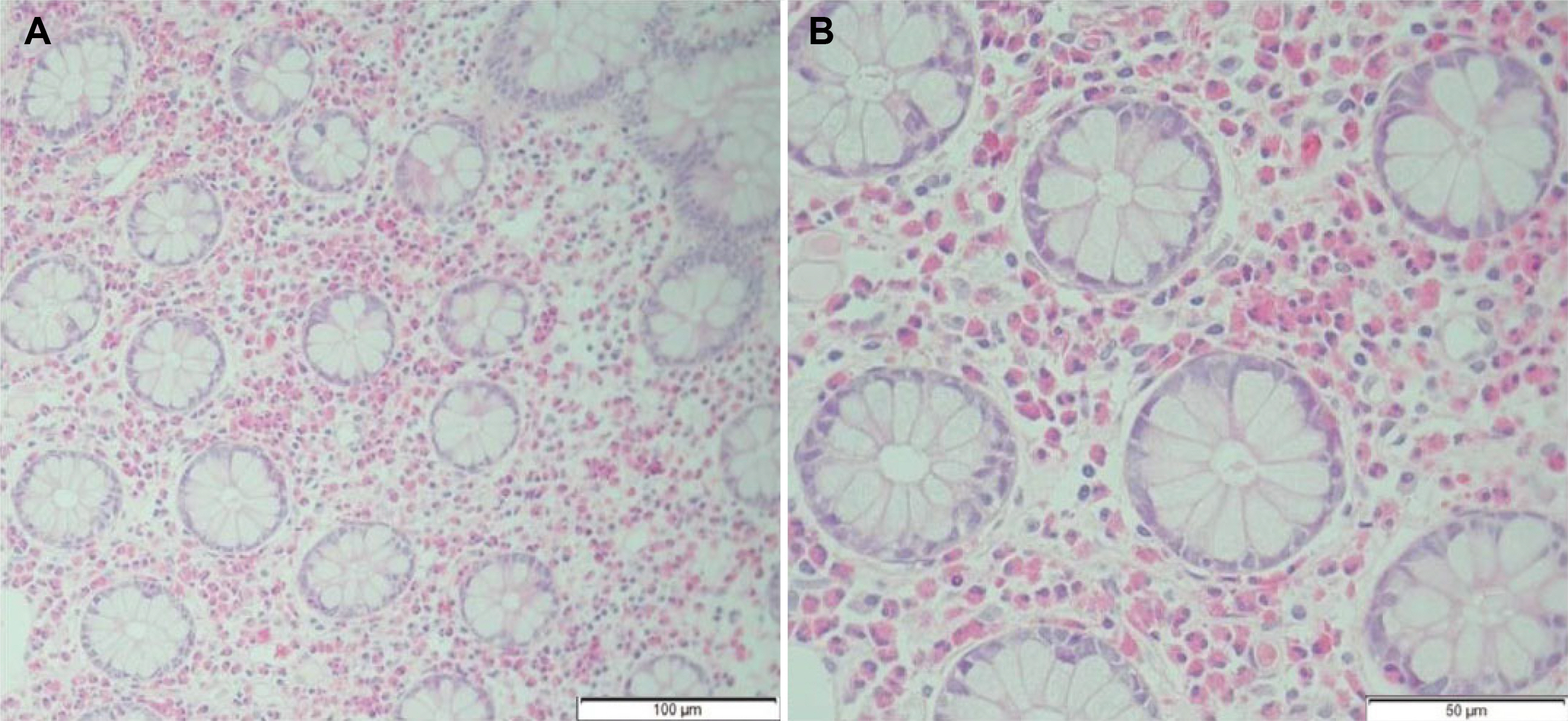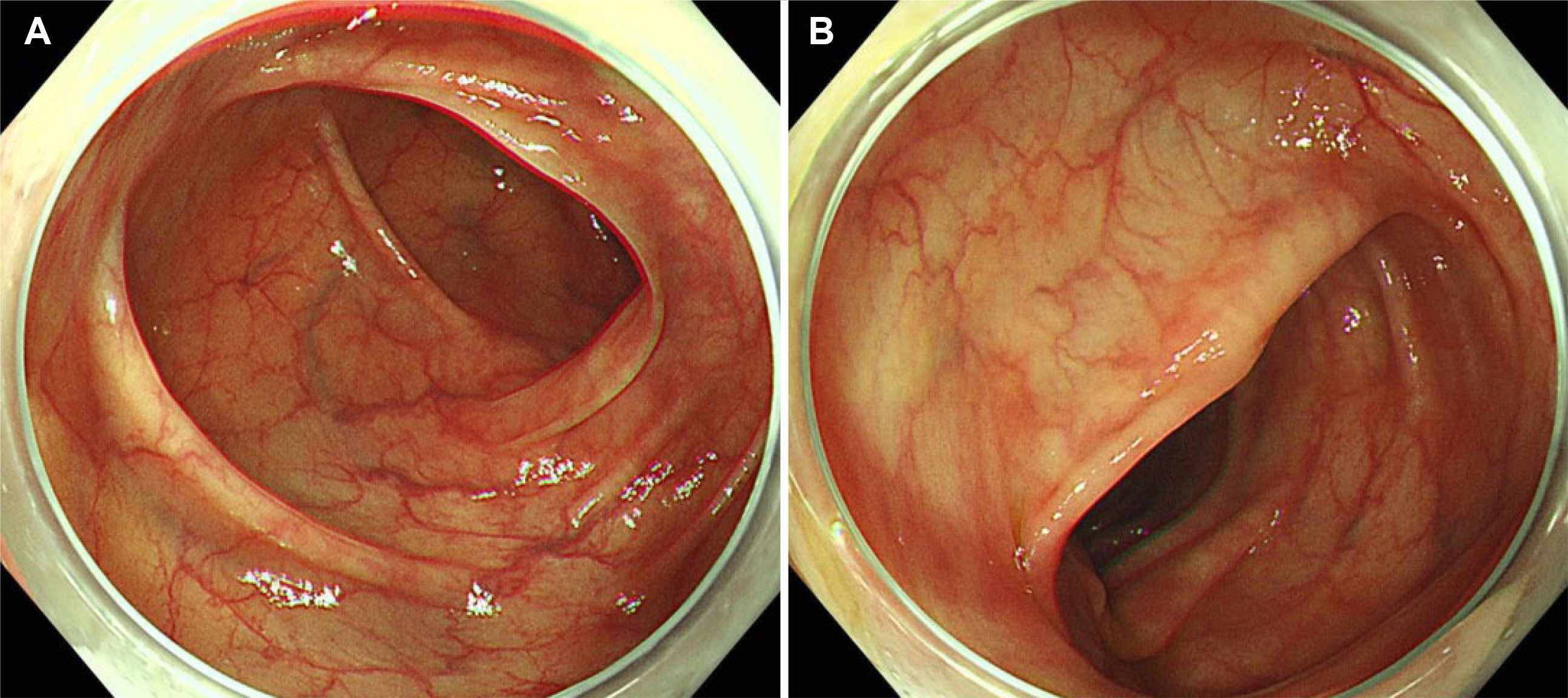Korean J Gastroenterol.
2021 Jun;77(6):300-304. 10.4166/kjg.2021.009.
Eosinophilic Colitis that Presented with Subepithelial Tumor-like Lesions
- Affiliations
-
- 1Division of Gastroenterology, Department of Internal Medicine, Good Samsun Hospital, Busan, Korea
- KMID: 2516891
- DOI: http://doi.org/10.4166/kjg.2021.009
Abstract
- Eosinophilic colitis is a rare disease that is characterized by eosinophilic infiltration in the colon wall in symptomatic patients. Thus far, the epidemiology and pathophysiology of eosinophilic colitis have not been well defined, but the hypersensitivity response is likely to play a role in its pathogenesis. The clinical presentation of eosinophilic colitis is usually nonspecific and depends on the layer of the intestinal wall affected by the eosinophilic infiltrate. Eosinophilic colitis is diagnosed generally by exclusion, i.e., after all other causes of eosinophilic infiltration have been excluded. Although there is no consensus over its diagnostic criteria, the laboratory results and radiology and endoscopy findings can provide important diagnostic evidence. This paper reports a case of eosinophilic colitis presenting as subepithelial tumor-like lesions in a 41-year-old man with the chief complaints of abdominal pain and loose stools. The patient had no diseases and no food or drug allergies in his medical history. In general, the endoscopic findings of eosinophilic colitis can vary from a normal mucosa to frank ulcerations. In this case, however, endoscopy revealed subepithelial tumor-like lesions. The colon biopsy showed eosinophilic infiltration in the lamina propria. The patient was treated with steroids, and his symptoms regressed with no signs of relapse.
Keyword
Figure
Reference
-
1. Alfadda AA, Storr MA, Shaffer EA. 2011; Eosinophilic colitis: epidemiology, clinical features, and current management. Therap Adv Gastroenterol. 4:301–309. DOI: 10.1177/1756283X10392443. PMID: 21922029. PMCID: PMC3165205.
Article2. Alfadda AA, Shaffer EA, Urbanski SJ, Storr MA. 2014; Eosinophilic colitis is a sporadic self-limited disease of middle-aged people: a population-based study. Colorectal Dis. 16:123–129. DOI: 10.1111/codi.12464. PMID: 24138295.
Article3. Jensen ET, Martin CF, Kappelman MD, Dellon ES. 2016; Prevalence of eosinophilic gastritis, gastroenteritis, and colitis: estimates from a national administrative database. J Pediatr Gastroenterol Nutr. 62:36–42. DOI: 10.1097/MPG.0000000000000865. PMID: 25988554. PMCID: PMC4654708.4. Díaz Del Arco C, Taxonera C, Olivares D, Fernández Aceñero MJ. 2018; Eosinophilic colitis: case series and literature review. Pathol Res Pract. 214:100–104. DOI: 10.1016/j.prp.2017.09.029. PMID: 29103770.
Article5. Uzunismail H, Hatemi I, Doğusoy G, Akin O. 2006; Dense eosinophilic infiltration of the mucosa preceding ulcerative colitis and mimicking eosinophilic colitis: report of two cases. Turk J Gastroenterol. 17:53–57. PMID: 16830279.6. Ahmad M, Soetikno RM, Ahmed A. 2000; The differential diagnosis of eosinophilic esophagitis. J Clin Gastroenterol. 30:242–244. DOI: 10.1097/00004836-200004000-00007. PMID: 10777180.
Article7. Yan BM, Shaffer EA. 2009; Primary eosinophilic disorders of the gastrointestinal tract. Gut. 58:721–732. DOI: 10.1136/gut.2008.165894. PMID: 19052023.
Article8. Mansoor E, Saleh MA, Cooper GS. 2017; Prevalence of eosinophilic gastroenteritis and colitis in a population-based study, from 2012 to 2017. Clin Gastroenterol Hepatol. 15:1733–1741. DOI: 10.1016/j.cgh.2017.05.050. PMID: 28603057.
Article9. Guajardo JR, Plotnick LM, Fende JM, Collins MH, Putnam PE, Rothenberg ME. 2002; Eosinophil-associated gastrointestinal disorders: a world-wide-web based registry. J Pediatr. 141:576–581. DOI: 10.1067/mpd.2002.127663. PMID: 12378201.
Article10. Klein NC, Hargrove RL, Sleisenger MH, Jeffries GH. 1970; Eosinophilic gastroenteritis. Medicine (Baltimore). 49:299–319. DOI: 10.1097/00005792-197007000-00003. PMID: 5426746. PMCID: PMC5604677.
Article11. Velchuru VR, Khan MA, Hellquist HB, Studley JG. 2007; Eosinophilic colitis. J Gastrointest Surg. 11:1373–1375. DOI: 10.1007/s11605-006-0055-1. PMID: 17849167.
Article12. Pineton de Chambrun G, Gonzalez F, Canva JY, et al. 2011; Natural history of eosinophilic gastroenteritis. Clin Gastroenterol Hepatol. 9:950–956.e1. DOI: 10.1016/j.cgh.2011.07.017. PMID: 21806952.
Article13. Zhang M, Li Y. 2017; Eosinophilic gastroenteritis: a state-of-the-art review. J Gastroenterol Hepatol. 32:64–72. DOI: 10.1111/jgh.13463. PMID: 27253425.
Article14. Anuradha C, Mittal R, Yacob M, Manipadam MT, Kurian S, Eapen A. 2012; Eosinophilic disorders of the gastrointestinal tract: imaging features. Diagn Interv Radiol. 18:183–188. DOI: 10.4261/1305-3825.DIR.4490-11.1. PMID: 21948696.
Article15. Turner KO, Sinkre RA, Neumann WL, Genta RM. 2017; Primary colonic eosinophilia and eosinophilic colitis in adults. Am J Surg Pathol. 41:225–233. DOI: 10.1097/PAS.0000000000000760. PMID: 27792062.
Article16. Okpara N, Aswad B, Baffy G. 2009; Eosinophilic colitis. World J Gastroenterol. 15:2975–2979. DOI: 10.3748/wjg.15.2975. PMID: 19554649. PMCID: PMC2702104.
Article17. Lee CM, Changchien CS, Chen PC, et al. 1993; Eosinophilic gastroenteritis: 10 years experience. Am J Gastroenterol. 88:70–74. PMID: 8420276.18. Lampinen M, Rönnblom A, Amin K, et al. 2005; Eosinophil granulocytes are activated during the remission phase of ulcerative colitis. Gut. 54:1714–1720. DOI: 10.1136/gut.2005.066423. PMID: 15886302. PMCID: PMC1774808.
Article19. Al-Haddad S, Riddell RH. 2005; The role of eosinophils in inflammatory bowel disease. Gut. 54:1674–1675. DOI: 10.1136/gut.2005.072595. PMID: 16284283. PMCID: PMC1774805.
Article20. Gupta N, Aggarwal A, Gupta R, Sule S, Wolf DC. 2015; The management of eosinophilic gastroenteritis. Scand J Gastroenterol. 50:1309–1314. DOI: 10.3109/00365521.2015.1049655. PMID: 26027839.
Article
- Full Text Links
- Actions
-
Cited
- CITED
-
- Close
- Share
- Similar articles
-
- Eosinophilic Colitis Presenting with Bloody Diarrhea: Case Report
- A Case of Steroid Treated Amebic Colitis Misdiagnosed as Eosinophilic Colitis
- Incidental Gastrointestinal Subepithelial Mass
- Recurrent Eosinophilic Pneumonia Associated with Mesalazine Suppository in a Patient with Ulcerative Colitis
- Esosinophilic Gastroenteritis with Clostridium difficile-associated Colitis: A Case Report





